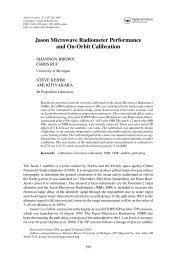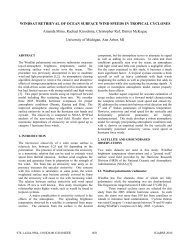Sensitivity of the Kurtosis Statistic as a Detector - Remote Sensing ...
Sensitivity of the Kurtosis Statistic as a Detector - Remote Sensing ...
Sensitivity of the Kurtosis Statistic as a Detector - Remote Sensing ...
Create successful ePaper yourself
Turn your PDF publications into a flip-book with our unique Google optimized e-Paper software.
DE ROO et al.: SENSITIVITY OF THE KURTOSIS STATISTIC 1939<br />
signal, higher order moments are uniquely determined by <strong>the</strong><br />
standard deviation. The kurtosis <strong>of</strong> v is defined <strong>as</strong><br />
R = m 4<br />
m 2 . (3)<br />
2<br />
Fig. 1. Example <strong>of</strong> predetection signals. On <strong>the</strong> left are time-domain representations<br />
<strong>of</strong> <strong>the</strong> signals. Their pdfs are shown on <strong>the</strong> right. Geophysical signals<br />
and receiver noise are Gaussian distributed in amplitude (top), while sinusoids<br />
have a distinctly non-Gaussian pdf (bottom).<br />
Aviation Administration. These L-band radars are distributed<br />
throughout <strong>the</strong> U.S. and transmit at megawatt peak power levels<br />
with center frequencies that range from 1215–1380 MHz [11],<br />
which is very close to <strong>the</strong> L-band p<strong>as</strong>sive band in <strong>the</strong> range<br />
<strong>of</strong> 1400–1427 MHz. ARSR-1 radars transmit with a 0.072%<br />
duty cycle, while ARSR-4 radars transmit with a 1%–3.24%<br />
duty cycle.<br />
II. PRINCIPLE OF KURTOSIS-BASED RFI DETECTION<br />
IN MICROWAVE RADIOMETRY<br />
The signal detected by a microwave radiometer is primarily<br />
from natural <strong>the</strong>rmal emission <strong>as</strong> well <strong>as</strong> <strong>the</strong>rmal noise generated<br />
by <strong>the</strong> hardware. The probability density function (pdf)<br />
<strong>of</strong> <strong>the</strong> amplitude <strong>of</strong> this signal is Gaussian distributed. The<br />
most likely form <strong>of</strong> RFI is sinusoidal, which h<strong>as</strong> a completely<br />
different amplitude distribution, <strong>as</strong> shown in Fig. 1.<br />
In <strong>the</strong> absence <strong>of</strong> RFI, <strong>the</strong> random voltage v at <strong>the</strong> input<br />
to a digitizer is given by <strong>the</strong> Gaussian probability density<br />
p g (v), i.e.,<br />
p g (v) = 1<br />
σ √ 2π e −v2<br />
2σ 2 . (1)<br />
The RFI detection algorithm makes use <strong>of</strong> <strong>the</strong> higher order<br />
moments <strong>of</strong> <strong>the</strong> random variable v. The central moments <strong>of</strong> <strong>the</strong><br />
distribution are given by<br />
m g n = 〈(v −〈v〉) n 〉 =1· 3 ······(n − 1)σ n (2)<br />
where σ is <strong>the</strong> standard deviation <strong>of</strong> v and n is even. The moment<br />
m n =0when n is odd. In c<strong>as</strong>e <strong>of</strong> a Gaussian-distributed<br />
For a Gaussian-distributed signal, <strong>the</strong> kurtosis is equal to 3,<br />
independent <strong>of</strong> σ. In c<strong>as</strong>e <strong>the</strong> signal is corrupted by RFI, <strong>the</strong><br />
probability may deviate from a Gaussian distribution, and <strong>the</strong><br />
value <strong>of</strong> <strong>the</strong> kurtosis may deviate from 3.<br />
The detection <strong>of</strong> RFI thus reduces to <strong>the</strong> problem <strong>of</strong> deciding<br />
from its samples if a variable is normally distributed. This<br />
is a well-documented area <strong>of</strong> research [12]. The momentratio-b<strong>as</strong>ed<br />
methods are especially appealing for radiometric<br />
operation because calculations <strong>of</strong> <strong>the</strong> test statistic are simple<br />
(and <strong>the</strong>refore f<strong>as</strong>t), <strong>the</strong>y do not require significant data storage<br />
(e.g., no ranking <strong>of</strong> data is required), and <strong>the</strong> postdetect data<br />
transmission rate is not significantly different from current<br />
receiver technologies that do not employ RFI detection. In<br />
addition, <strong>the</strong> statistic R is independent <strong>of</strong> <strong>the</strong> statistic m 2 for<br />
a Gaussian distribution [12]. Therefore, estimates <strong>of</strong> m 2 and<br />
hence <strong>of</strong> <strong>the</strong> brightness temperature will be unbi<strong>as</strong>ed by <strong>the</strong><br />
removal <strong>of</strong> samples incorrectly flagged <strong>as</strong> containing RFI by a<br />
kurtosis-b<strong>as</strong>ed algorithm. RFI detection algorithms which rely<br />
on brightness thresholds may be bi<strong>as</strong>ed because high outliers<br />
are suppressed.<br />
III. KURTOSIS IN THE ABSENCE OF RFI<br />
While <strong>the</strong> kurtosis is ideally equal to 3 for a Gaussian distribution,<br />
<strong>the</strong> me<strong>as</strong>urement process results in a sample estimate<br />
<strong>of</strong> <strong>the</strong> kurtosis that can deviate from <strong>the</strong> <strong>the</strong>oretical value. This<br />
section explores some mechanisms <strong>of</strong> <strong>the</strong> me<strong>as</strong>urement process<br />
and how <strong>the</strong>y can affect <strong>the</strong> estimate <strong>of</strong> <strong>the</strong> kurtosis when no<br />
RFI is present.<br />
A. Effects <strong>of</strong> Finite Number <strong>of</strong> Independent Samples<br />
Because <strong>the</strong> kurtosis is estimated from a finite sample set, it<br />
is itself a random variable. Let its pdf be denoted by p(R; N),<br />
where N is <strong>the</strong> number <strong>of</strong> independent samples. The area under<br />
<strong>the</strong> outlying tails <strong>of</strong> <strong>the</strong> pdf determines <strong>the</strong> rate <strong>of</strong> false detections<br />
<strong>of</strong> RFI in o<strong>the</strong>rwise RFI-free radiometric observations.<br />
Closed-form expressions for p(R; N) exist only for N =4<br />
[13], which is a sample size that is much too small for practical<br />
utility. Fortunately, <strong>the</strong> moments <strong>of</strong> p(R; N) are known<br />
exactly for arbitrary N up to <strong>the</strong> seventh moment [14]–[16]<br />
and can be used to estimate <strong>the</strong> area under its tails. In <strong>the</strong><br />
limit <strong>of</strong> large N, p(R; N) tends toward normal with mean<br />
〈R〉 =3(N − 1)/(N +1) and variance that <strong>as</strong>ymptotically<br />
approaches 24/N . The normal approximation requires a ra<strong>the</strong>r<br />
large N (N >50 000). For radiometer applications with very<br />
fine bandwidth resolution and very short integration times, <strong>the</strong><br />
non-Gaussian nature <strong>of</strong> p(R; N) should be taken into account<br />
in order to minimize <strong>the</strong> false alarms <strong>of</strong> RFI detection.<br />
A common moment-b<strong>as</strong>ed estimator for pdfs and cumulative<br />
distribution functions (CDFs) is <strong>the</strong> Edgeworth series [17],<br />
but this series generates negative values for <strong>the</strong> pdf in <strong>the</strong><br />
tails, resulting in poor area estimates under <strong>the</strong> tails. Bowman





